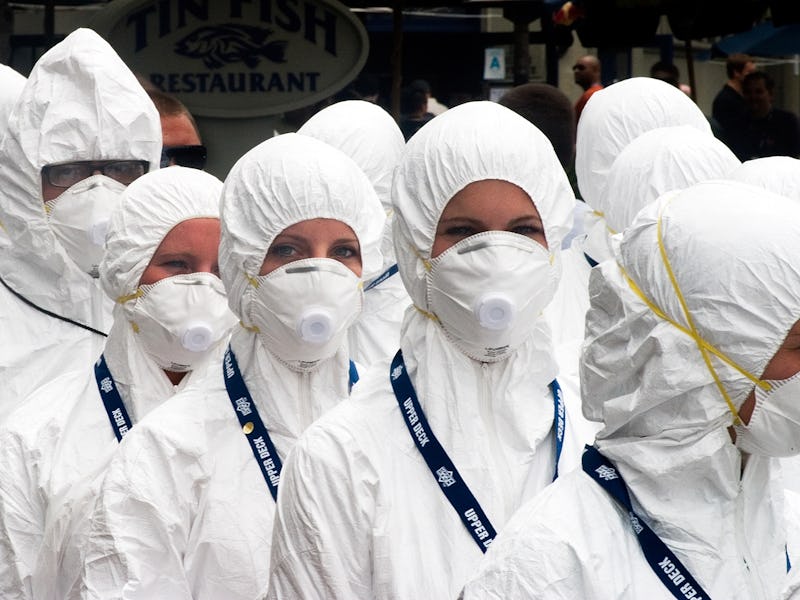10 Fictional Diseases (and the Real Ones That Inspired Them)
Don't touch your face.

Our favorite movies, TV shows, books, and other pop culture are in no hurry to stop scaring us. Zombie apocalypses and rabid monkeys that force a quarantine will always push protagonists to the edge so long as we keep fearing death.
But some afflictions aren’t too far off from our real world. While we have yet to see a single real zombie on the evening news, here are eleven fictional diseases that may just be one accident in a lab away from happening.
Greyscale
Plaguing the lands outside Westerns is greyscale, and just thinking about it will make you apply Aveeno. A very contagious skin disease, greyscale hardens the flesh like stone and discolors it into grey or black. In its early stages it will calcify an area of skin and crack like thin ice with movement, but over time it spreads throughout turning warm bodies into dry husks. Victims are either euthanized or cast off and left to rot in distant Valyrian ruins.
Real world equivalent: Smallpox and leprosy. Like smallpox, immunity is developed by the afflicted. Like leprosy, it’s a hideous skin affliction with an extreme stigma by society.
Inferno
The latest Dan Brown novel, Inferno, features the titular virus that is intended to render victims infertile. Originally weaponized as waterborne, the novel’s villains altered it to travel via air purely because it’s faster.
Real world equivalent: The infamous Black Plague.
Legacy Virus
The Legacy Virus was a viroid that targeted the mutants who inhabited the sprawling Marvel universe. From 2,000 years from the future and released in the present, Legacy works by targeting the infected’s X-factor — the genes that give mutants their super powers — and inserting junk DNA sequence in their RNA. The host body becomes unable to replicate healthy cells, resulting in death.
Real world equivalent: HIV and AIDS. Marvel’s X-Men series have always been politically and socially-minded, serving as parables for LGBTQ and ethnic minorities fighting for civil rights. Things were no different when the Legacy storyline began in 1993. According to former X-Men writer Fabian Nicieza, the team “were well informed by the thematic underpinnings of prejudice against gays” from the AIDS outbreak of the late ‘80s.
Bendii Syndrome
Pronounced “ben-dye,” Bendii Syndrome is a generative neurological illness that effects a few elderly Vulcans on Next Generation. Besides weakness, fever, and fatigue, victims experience an accelerating loss of emotional control. That’s pretty big, because Vulcans losing control is highly illogical.
Real world equivalent: Alzheimer’s disease. Losing control of emotions is as painful for Vulcans as losing memory for humans.
Mad Snail Disease
At the height of the mad cow disease plaguing the 24-hour news cycle a few years ago, SpongeBob of all shows managed a clever spoof. Spread into a host body after a bite from an infected snail, the victim suffers bloodshot eyes, messy pants, severely untrimmed toenails, ticklish ribcages, and loss of balance. Sounds like everyone at spring break.
Real world equivalent: Infected snails are similar to rabid animals, such as their foaming mouths, paranoia, and aggression. But for everyone else, clearly mad cow disease. If only for its sensationalized media coverage.
The Andromeda Strain
The titular virus of Michael Crichton’s novel, the disease is a green, crystalline agent of alien origin. It erodes the vessel walls of the circulatory system, resulting in coagulation response or cerebral hematomas. However, if your blood contains too much alkaline or is too acidic, you’d be lucky. The strain can only survive in a narrow pH range.
Real world equivalent: None, but as a kind of reverse the pandemics since the book’s release — from the bird flu to ebola — have evoked the Andromeda Strain in some way. Also, Michael Crichton’s book was released just weeks before the moon landing when there was a paranoia that the astronauts could bring back germs from the moon.
Mad Zombie Disease
Mad cow disease shows up once again! This time as a killer to humans that turns them into the brain-eating bullet fodder we now love. The hilarious Zombieland cut through the BS and made understanding this as simple as possible: One bite and you’re a zombie. Take note, The Walking Dead.
Real world equivalent: Mad cow disease. Obviously.
TS-19
On The Walking Dead, the virus that cripples the world is already carried by everyone. It is still unknown how it was spread, but all humans now suffer extremely weakened immune systems, making even the most minor illnesses fatal and spawning a zombie. All the signature symptoms checked off: dizziness, fatigue, chills, nausea, soreness, pupil dilation, dehydration, coughing blood, you name it. And it’s not the actual zombie bite that spread the infection, but the extremely resistant bacteria in the mouths of the zombies.
Electrogonorrea
Did you find that last part gross? That's to segue to electrogonorrea! From Futurama, electrogonorrea is a sexually-transmitted disease that afflicts humans after sexual contact with robots. With all those eerie robots Japan has been making lately, we should fear the day this could be real.
Real world equivalent: Nothing similar exists, which is a damn good thing for sexually active toasters.
The Genophage
Throughout the crazy-successful Mass Effect video game series, players are taught about an infertility disease called the genophage and are given a chance to possibly cure it.
A bioweapon used against the violent, orc-ish krogans from a previous war, the genophage stunted korgan birthrates resulting in overwhelming stillborns that brought them to the brink of extinction.
Depending how players engage the story, they will find themselves at the crossroads of a moral dilemma: Correct a war crime, or allow a violent, dangerous culture to die. No one said saving the galaxy would be easy.
Real world equivalent: Although not a disease, genophage’s function as a bioweapon was similar to Agent Orange used in the Vietnam War. There are very clear differences between the two, but it’s not difficult to see the thematic similarities.